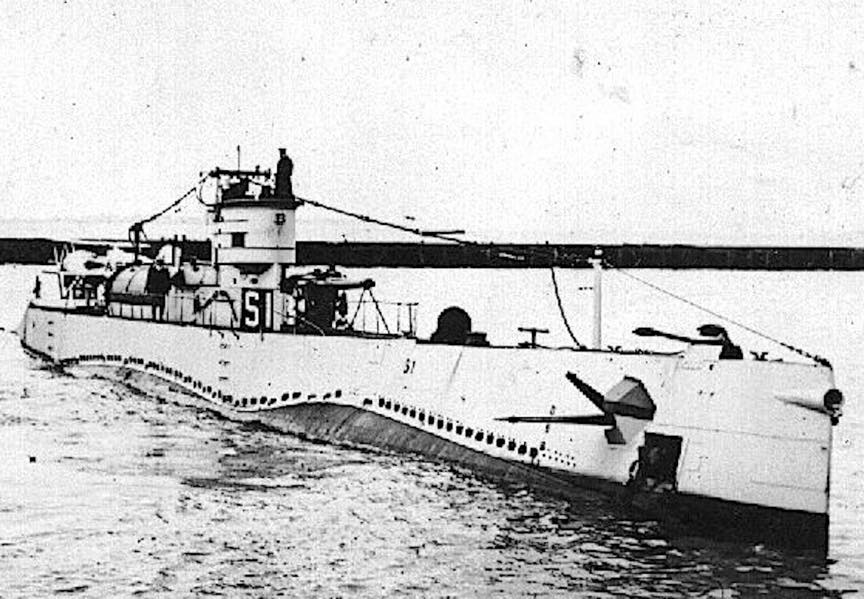S-1 SS-105

S-l
(SS-105: dp. 854 (surf.), 1,062 (subm.); 1. 219'3", b. 20'8", dr. 15'11" (mean), s. 14.5 k. (surf.), 11 k.(subm.); cpl. 38; a. 4 21" tt., 1 4"; cl. S-1)
S-1 (SS-105) was laid down on 11 December 1917 by the Fore River Shipbuilding Co., Quincy, Mass. launched on 26 October 1918; sponsored by Mrs. Emory S. Land; and commissioned on 5 June 1920, Lt. Comdr. Thomas G. Berrien in command.
S-1, first of the "S" class submarines, was a "Holland-type" which was subcontracted to the Fore River SB Co. by the Electric Boat Co. The Navy had awarded contracts for three of the S-boats under the same general specifications but of different design types. S-2 was known as the "Lake-type" and S-d as the "Government-type."
S—1 began her service operations in July 1920 with a cruise to Bermuda attached to Submarine Division 2 (SubDiv 2), with subsequent operations out of New London, cruising the New England coast until 1923.
On 2 January 1923, she shifted to SubDiv Zero, a division created for experimental work, and with two groups under SubDiv 11, joined other fleet units, and conducted winter maneuvers in the Caribbean. As a single ship division, SubDiv Zero, she returned to New London in the spring to continue experimental duty.
As a result of studies conducted by the Navy, following World War I, into the possibility of submarineborne observation and scouting aircraft, S-1 became the experimental platform for this project, late in 1923. She was altered by having a steel capsule mounted abaft the conning tower. a cylindrical pod which could house a small collapsible seaplane, the Martin MS-1. After surfacing, this plane could be rolled out, quickly assembled, and launched by balancing the sub until the deck was awash. These experiments were carried out into 1926 using the Martinbuilt plane, constructed of wood and fabric, and the all metal Cox-Klein versions, XS-1 and XS-2. The first full cycle of surfacing, assembly, launching, retrieving disassembly, and submergence took place on 28 July 1926 on the Thames River at New London.
Following the aircraft experiments, S-1 served as flagship for SubDiv 2 until July 1927, when she was transferred to SubDiv 4. While attached to this division, she made operational cruises to the Panama Canal Zone in 1928, 1929, and 1930, during the spring months. She visited ports at Cristobal and Coco Solo Canal Zone; Cartagena, Colombia; Kingston, Jamaica, and Guantanamo Bay, Cuba, during these cruises, and spent the remaining months of those years operating along the New England coast, out of New London.
January 1931 found her at Pearl Harbor. She remained there into 1937; first, attached to SubDiv 7 SubRon 4, then, from July 1932 to July 1933, attached to Rotating Reserve SubDiv 14. She was returned to SubDiv 7 in August 1933 and remained with that division until departing in May 1937 for Philadelphia. S-1 arrived at Philadelphia on 22 July and commenced overhaul for deactivation. She was decommissioned on 20 October.
On 16 October 1940, S-1 was recommissioned at Philadelphia. She then made two cruises to Bermuda, training submariners, and returned to Philadelphia from the second cruise on 7 December 1941. There she prepared for transfer to the United Kingdom under lend lease. She was decommissioned and turned over to the British on 20 April 1942. Her name was struck from the Navy list on 24 June 1942.
S-1 served the Royal Navy as HMS P. 552. Returned to U.S. custody on 16 October 1944 at Durban, Natal, Union of South Africa, she was stripped of vital parts and machinery, and her hull was sold on 20 July 1945. She was scrapped at Durban on 14 September of that year.
